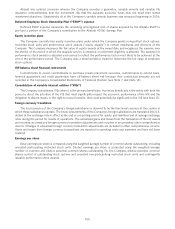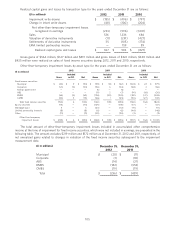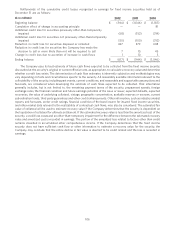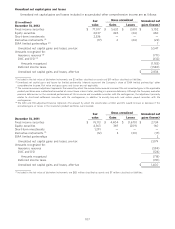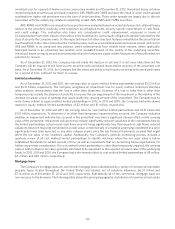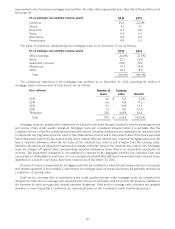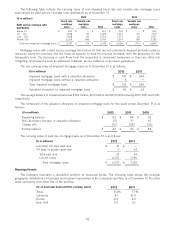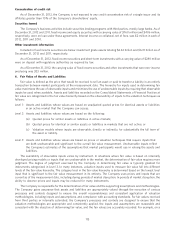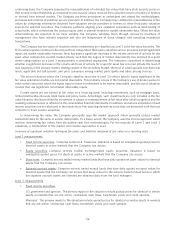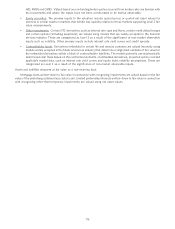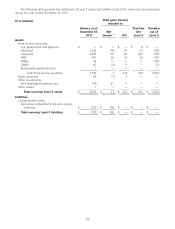Allstate 2013 Annual Report Download - page 226
Download and view the complete annual report
Please find page 226 of the 2013 Allstate annual report below. You can navigate through the pages in the report by either clicking on the pages listed below, or by using the keyword search tool below to find specific information within the annual report.amortized cost for a period of twelve or more consecutive months as of December 31, 2012. Unrealized losses on below
investment grade securities are principally related to ABS, RMBS and CMBS and were the result of wider credit spreads
resulting from higher risk premiums since the time of initial purchase. These wider spreads are largely due to the risk
associated with the underlying collateral supporting certain ABS, RMBS and CMBS securities.
ABS, RMBS and CMBS in an unrealized loss position were evaluated based on actual and projected collateral losses
relative to the securities’ positions in the respective securitization trusts, security specific expectations of cash flows,
and credit ratings. This evaluation also takes into consideration credit enhancement, measured in terms of
(i) subordination from other classes of securities in the trust that are contractually obligated to absorb losses before the
class of security the Company owns, (ii) the expected impact of other structural features embedded in the securitization
trust beneficial to the class of securities the Company owns, such as overcollateralization and excess spread, and (iii) for
ABS and RMBS in an unrealized loss position, credit enhancements from reliable bond insurers, where applicable.
Municipal bonds in an unrealized loss position were evaluated based on the quality of the underlying securities.
Unrealized losses on equity securities are primarily related to temporary equity market fluctuations of securities that are
expected to recover.
As of December 31, 2012, the Company has not made the decision to sell and it is not more likely than not the
Company will be required to sell fixed income securities with unrealized losses before recovery of the amortized cost
basis. As of December 31, 2012, the Company had the intent and ability to hold equity securities with unrealized losses
for a period of time sufficient for them to recover.
Limited partnerships
As of December 31, 2012 and 2011, the carrying value of equity method limited partnerships totaled $3.52 billion
and $3.13 billion, respectively. The Company recognizes an impairment loss for equity method limited partnerships
when evidence demonstrates that the loss is other than temporary. Evidence of a loss in value that is other than
temporary may include the absence of an ability to recover the carrying amount of the investment or the inability of the
investee to sustain a level of earnings that would justify the carrying amount of the investment. The Company had no
write-downs related to equity method limited partnerships in 2012. In 2011 and 2010, the Company had write-downs
related to equity method limited partnerships of $2 million and $1 million, respectively.
As of December 31, 2012 and 2011, the carrying value for cost method limited partnerships was $1.41 billion and
$1.57 billion, respectively. To determine if an other-than-temporary impairment has occurred, the Company evaluates
whether an impairment indicator has occurred in the period that may have a significant adverse effect on the carrying
value of the investment. Impairment indicators may include: significantly reduced valuations of the investments held by
the limited partnerships; actual recent cash flows received being significantly less than expected cash flows; reduced
valuations based on financing completed at a lower value; completed sale of a material underlying investment at a price
significantly lower than expected; or any other adverse events since the last financial statements received that might
affect the fair value of the investee’s capital. Additionally, the Company’s portfolio monitoring process includes a
quarterly review of all cost method limited partnerships to identify instances where the net asset value is below
established thresholds for certain periods of time, as well as investments that are performing below expectations, for
further impairment consideration. If a cost method limited partnership is other-than-temporarily impaired, the carrying
value is written down to fair value, generally estimated to be equivalent to the reported net asset value of the underlying
funds. In 2012, 2011 and 2010, the Company had write-downs related to cost method limited partnerships of $8 million,
$4 million and $45 million, respectively.
Mortgage loans
The Company’s mortgage loans are commercial mortgage loans collateralized by a variety of commercial real estate
property types located throughout the United States and totaled, net of valuation allowance, $6.57 billion and
$7.14 billion as of December 31, 2012 and 2011, respectively. Substantially all of the commercial mortgage loans are
non-recourse to the borrower. The following table shows the principal geographic distribution of commercial real estate
110


